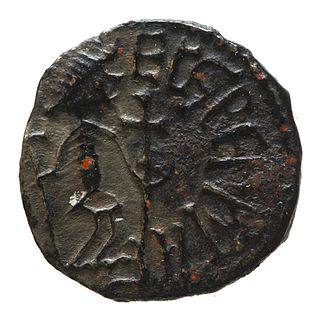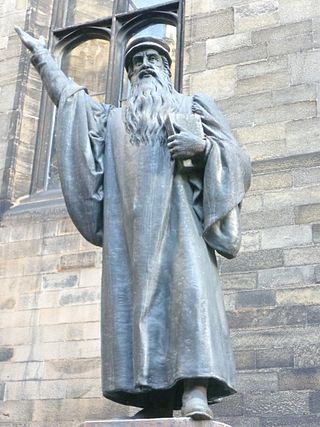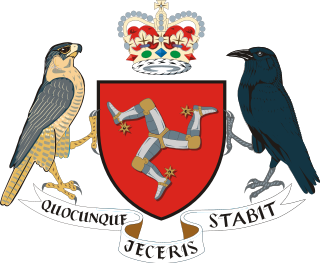Related Research Articles

Bede, also known as Saint Bede, the Venerable Bede, and Bede the Venerable, was an English monk and an author and scholar. He was one of the greatest teachers and writers during the Early Middle Ages, and his most famous work, Ecclesiastical History of the English People, gained him the title "The Father of English History". He served at the monastery of St Peter and its companion monastery of St Paul in the Kingdom of Northumbria of the Angles.
Canon law is a set of ordinances and regulations made by ecclesiastical authority for the government of a Christian organization or church and its members. It is the internal ecclesiastical law, or operational policy, governing the Catholic Church, the Eastern Orthodox and Oriental Orthodox churches, and the individual national churches within the Anglican Communion. The way that such church law is legislated, interpreted and at times adjudicated varies widely among these four bodies of churches. In all three traditions, a canon was originally a rule adopted by a church council; these canons formed the foundation of canon law.

Justus was the fourth Archbishop of Canterbury. Pope Gregory the Great sent Justus from Italy to England on a mission to Christianize the Anglo-Saxons from their native paganism, probably arriving with the second group of missionaries despatched in 601. Justus became the first Bishop of Rochester in 604 and attended a church council in Paris in 614.
Simony is the act of selling church offices and roles or sacred things. It is named after Simon Magus, who is described in the Acts of the Apostles as having offered two disciples of Jesus payment in exchange for their empowering him to impart the power of the Holy Spirit to anyone on whom he would place his hands. The term extends to other forms of trafficking for money in "spiritual things".

Mark the Evangelist also known as John Mark or Saint Mark, is the person who is traditionally ascribed to be the author of the Gospel of Mark. Modern Bible scholars have concluded that the Gospel of Mark was written by an anonymous author rather than an identifiable historical figure. According to Church tradition, Mark founded the episcopal see of Alexandria, which was one of the five most important sees of early Christianity. His feast day is celebrated on April 25, and his symbol is the winged lion.
Autocephaly is the status of a hierarchical Christian church whose head bishop does not report to any higher-ranking bishop. The term is primarily used in Eastern Orthodox and Oriental Orthodox Churches. The status has been compared with that of the churches (provinces) within the Anglican Communion.

Odathe Good was a 10th-century Archbishop of Canterbury in England. The son of a Danish invader, Oda became Bishop of Ramsbury before 928. A number of stories were told about his actions both prior to becoming and while a bishop, but few of these incidents are recorded in contemporary accounts. After being named to Canterbury in 941, Oda was instrumental in crafting royal legislation as well as involved in providing rules for his clergy. Oda was also involved in the efforts to reform religious life in England. He died in 958 and legendary tales afterwards were ascribed to him. Later he came to be regarded as a saint, and a hagiography was written in the late 11th or early 12th century.

An episcopal see is, in a practical use of the phrase, the area of a bishop's ecclesiastical jurisdiction.

A consistory court is a type of ecclesiastical court, especially within the Church of England where they were originally established pursuant to a charter of King William the Conqueror, and still exist today, although since about the middle of the 19th century consistory courts have lost much of their subject-matter jurisdiction. Each diocese in the Church of England has a consistory court.

In Christian churches with episcopal polity, the rank of metropolitan bishop, or simply metropolitan, pertains to the diocesan bishop or archbishop of a metropolis.
A churchwarden is a lay official in a parish or congregation of the Anglican Communion or Catholic Church, usually working as a part-time volunteer. In the Anglican tradition, holders of these positions are ex officio members of the parish board, usually called a vestry, parochial church council, or in the case of a Cathedral parish the chapter.

The Public Worship Regulation Act 1874 was an act of Parliament of the United Kingdom, introduced as a Private Member's Bill by Archbishop of Canterbury Archibald Campbell Tait, to limit what he perceived as the growing ritualism of Anglo-Catholicism and the Oxford Movement within the Church of England. The bill was strongly endorsed by Prime Minister Benjamin Disraeli, and vigorously opposed by Liberal party leader William Ewart Gladstone. Queen Victoria strongly supported it. The law was seldom enforced, but at least five clergymen were imprisoned by judges for contempt of court, which greatly embarrassed the Church of England archbishops who had vigorously promoted it.

Ecgbert was an 8th-century cleric who established the archdiocese of York in 735. In 737, Ecgbert's brother became king of Northumbria and the two siblings worked together on ecclesiastical issues. Ecgbert was a correspondent of Bede and Boniface and the author of a legal code for his clergy. Other works have been ascribed to him, although the attribution is doubted by modern scholars.
In English law and the canon law of the Church of England, a monition, contraction of admonition, is an order to a member of the clergy to do or refrain from doing a specified act. Other than a rebuke, it is the least severe censure available against clergy of the Church of England. Failure to observe the order is an offence under the Ecclesiastical Jurisdiction Measure 1963. A monition can be imposed in person by a bishop or by an ecclesiastical court.
The parson's freehold refers to a system within the Church of England in which the rector or vicar of a parish holds title to benefice property, such as the church, churchyard or parsonage, the ownership passing to his successor. This system is to be phased out, under the Ecclesiastical Offices Measure.

The Scottish Reformation was the process whereby Scotland broke away from the Catholic Church, and established the Protestant Church of Scotland. It forms part of the wider European 16th century Protestant Reformation.

The Vicar General of the Diocese of Sodor and Man is an ecclesiastical law officer appointed by the Bishop of Sodor and Man.
In English law and the canon law of the Church of England, a rebuke is a censure on a member of the clergy. It is the least severe censure available against clergy of the Church of England, less severe than a monition. A rebuke can be given in person by a bishop or by an ecclesiastical court.

The Waite Court refers to the Supreme Court of the United States from 1874 to 1888, when Morrison Waite served as the seventh Chief Justice of the United States. Waite succeeded Salmon P. Chase as Chief Justice after the latter's death. Waite served as Chief Justice until his death, at which point Melville Fuller was nominated and confirmed as Waite's successor.
References
Footnotes
- ↑ Ecclesiastical Jurisdiction Measure 1963
- ↑ Cross, F. L.; Livingstone, E. A., eds. (2005), "Ecclesiastical Jurisdiction Measure 1963", Oxford Dictionary of the Christian Church (online ed.), Oxford University Press, ISBN 978-0-19-280290-3 , retrieved 28 February 2013(subscription required)
- ↑ Massingberd (2001), p. 41
Bibliography
- Massingberd, Hugh, ed. (2001) [2 July 1987], "The Reverend Michael Bland", The Very Best of the Daily Telegraph Books of Obituaries, Pan Books, pp. 41–43, ISBN 978-0-330-48470-1